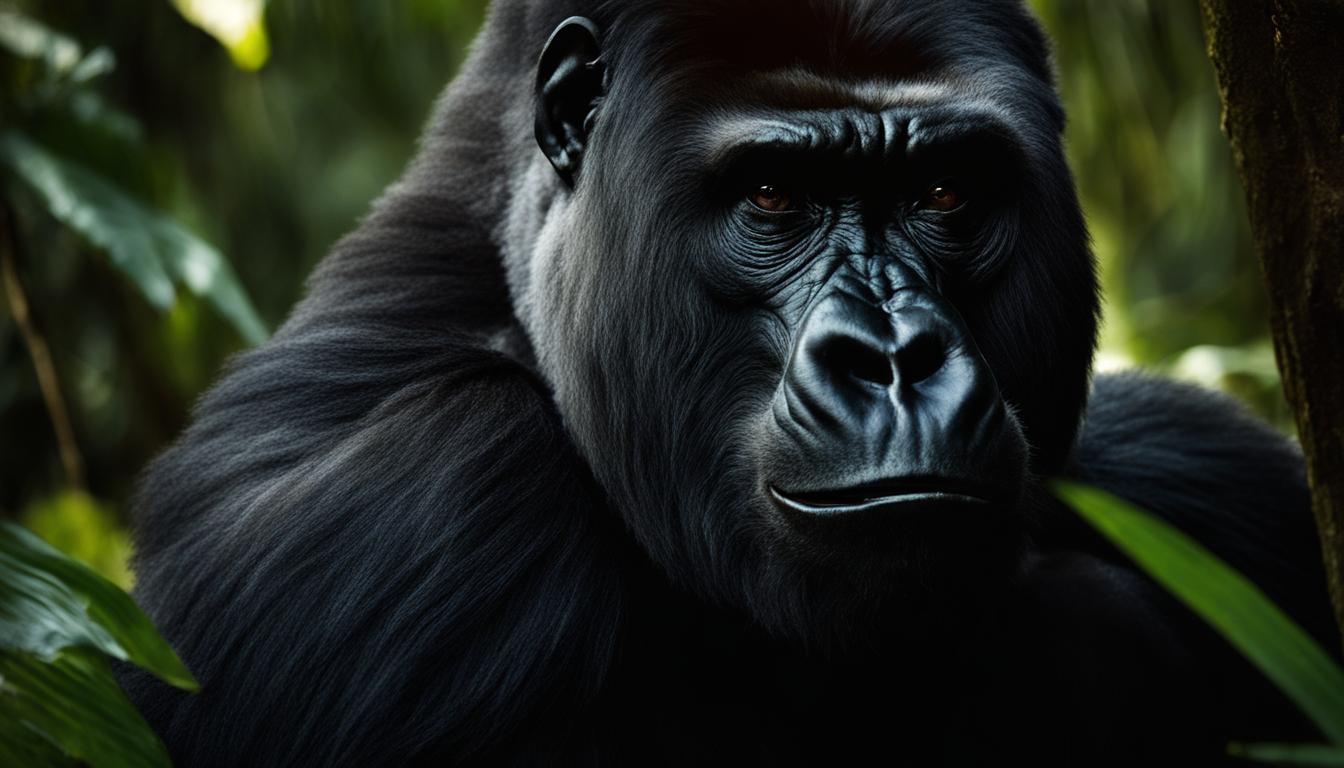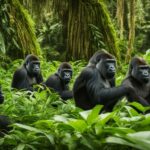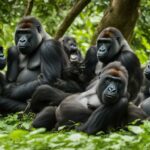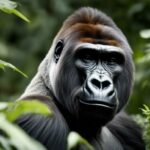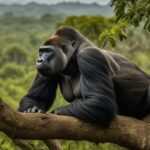Gorillas, the largest of all primates, possess a variety of distinctive physical features that set them apart from other animals. Their unique characteristics and appearances make them fascinating creatures to study and observe.
First and foremost, gorillas are known for their impressive size. Adult males can weigh up to 374 lbs (169.5 kg) in the case of Western lowland gorillas, and even reach weights of 484 lbs (220 kg) for mountain gorillas. Their stomachs are larger than their chests, and their arms are larger and stronger than their legs. With dark skin and black to brown-grey hair, gorillas have a massive head with a protruding forehead and a bony sagittal crest.
Gorillas’ hands and feet have opposable thumbs and big toes, allowing them to grasp and manipulate objects with ease. They also have 32 teeth, with adult males developing big, sharp canines. Furthermore, gorillas have a unique nose region used for individual identification, and interestingly, they lack a tail.
Gorilla adaptations and features
Gorillas have several remarkable adaptations and distinctive features that enable them to thrive in their environment. These adaptations have evolved over time to help gorillas survive and flourish in their natural habitats.
One key adaptation is the gorillas’ larger stomachs, which are attributed to their enlarged intestines. This allows them to properly digest the fibrous vegetation that makes up the bulk of their diet. The ability to efficiently extract nutrients from tough plant material is crucial for their survival.
Gorillas also have unique body proportions that aid in their specialized lifestyle. Their longer arms, compared to their legs, indicate a tree-dwelling ancestry. While they primarily walk on all fours, their arms are incredibly strong and are used for bending and gathering foliage. This physical feature allows them to efficiently forage for food and manipulate their environment.
Gorillas have a well-developed social structure, living in stable family groups led by dominant males.
Another notable feature of gorillas is their lack of hair on certain parts of their bodies. Gorillas do not have hair on their fingers, palms, soles, nose, lips, ears, and chest. This adaptation helps them maintain grip and dexterity when handling objects and navigating their surroundings. Additionally, gorillas possess scent glands in their armpits that produce a pungent odor when they are excited or stressed. These scent glands play a crucial role in communication among group members.
Lastly, gorillas exhibit a highly-developed social structure. They live in stable family groups led by dominant males, known as silverbacks. These family units provide protection, support, and a sense of community for each member. The intricate social dynamics within gorilla groups contribute to their overall success as a species.
Gorilla Adaptations and Features
| Adaptation/Feature | Description |
|---|---|
| Larger Stomachs | Gorillas’ enlarged intestines and stomachs aid in digesting fibrous vegetation. |
| Longer Arms | Gorillas’ longer arms, compared to their legs, facilitate efficient foraging and manipulation of their environment. |
| Lack of Hair | Gorillas have no hair on certain body parts, enhancing grip and dexterity. |
| Scent Glands | Gorillas possess scent glands in their armpits for communication within their group. |
| Social Structure | Gorillas live in stable family groups led by dominant males, providing support and protection. |
Conclusion
Gorillas possess several unique physical features that set them apart from other primates. Their large size, distinctive shape, powerful muscles, and silver-gray saddle make them easily recognizable. They are the largest of all primates, with adult males weighing up to 220 kg (484 lbs.) and females weighing around 71.5 kg (158 lbs.).
Adapted to their environment, gorillas have developed larger stomachs for digesting fibrous vegetation, and longer arms for gathering foliage and defense. They also have scent glands in their armpits for communication. Their dark skin and black to brown-grey hair, with silver-gray saddles on adult males, contribute to their physical appearance.
Overall, gorillas are fascinating creatures with a wide range of physical attributes. From their massive head with a protruding forehead and bony sagittal crest to their opposable thumbs and big toes, each feature serves a specific purpose. Gorillas’ unique nose region acts as an individual identifier, and their lack of a tail sets them apart from other primates.
In conclusion, gorillas’ physical characteristics make them highly distinctive and perfectly adapted to their habitat. It is truly remarkable to observe the strength and grace with which these magnificent creatures navigate their environment.
How do Gorillas’ Unique Physical Features Help with their Communication Methods?
Gorillas’ sounds and communication methods are closely linked to their unique physical features. Their deep chest allows them to produce powerful vocalizations, while their expressive facial muscles and body postures help convey emotions and intentions. These physical traits play a crucial role in the intricate communication system of gorilla groups.
FAQ
What is the size and weight of adult gorillas?
Adult male gorillas can weigh between 300-600 lb (135-275 kg), while adult females weigh about half that amount. Mountain gorillas can weigh up to 220 kg (484 lbs.) for males and 97.7 kg (215 lbs.) for females.
What are the unique physical features of gorillas?
Gorillas have a distinctive shape with their stomachs larger than their chests, their arms larger and stronger than their legs, and a massive head with a protruding forehead and a bony sagittal crest. They also have opposable thumbs and big toes, 32 teeth with adult males developing big, sharp canines, and a unique nose region used for individual identification. Gorillas lack a tail.
How strong are gorillas?
Gorillas have powerful muscles, particularly in their arms, which are six times more powerful than those of an adult human. This strength allows them to lift, break, and squeeze heavy objects.
What is the appearance of gorillas?
Gorillas have dark skin and black to brown-grey hair. Adult males develop silver-gray saddles on their backs. The silver-gray area creates an illusion of increased length and size. Lowland gorillas have shorter sparse hair, while mountain gorillas have long and silky hair. Gorillas also have individualized fingerprints and toeprints.
What adaptations do gorillas have?
Gorillas have larger stomachs for digesting fibrous vegetation, longer arms for bending and gathering foliage, and scent glands in their armpits for communication. They also have a well-developed social structure, living in stable family groups led by dominant males.
Do gorillas walk on all fours?
While gorillas have longer arms than legs, indicating a tree-dwelling ancestry, they primarily walk on all fours. However, they can also stand upright and walk bipedally for short distances.

